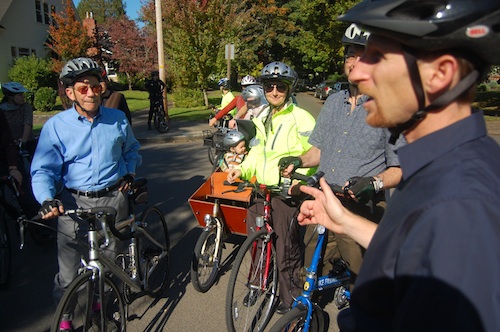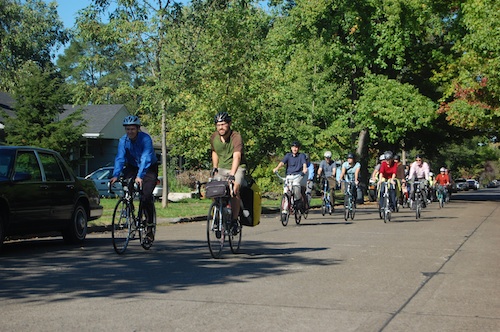Congressman Peter DeFazio (D-OR) used a late October bike ride as an enjoyable way to hear about recent active transportation projects built in Eugene with help from UO students.
DeFazio rode with students in the school of Architecture and Allied Arts and Dean Frances Bronet on a loop on and near campus. The ride was led by Marc Schlossberg, associate professor in the Department of Planning, Public Policy and Management, and Associate Director of the Sustainable Cities Initiative (SCI).

The route for the bike ride highlighted projects built or influenced by UO students and which address some federal transportation priorities targeting reductions in greenhouse gases, increasing the number of children who walk and bike to school, and creating a robust bicycle infrastructure for normal, everyday use.
“Our students are amazingly brilliant – they are energetic, have great insight, and desperately want to do good at the same time they are pursuing their academic interests,” says Schlossberg. “This ride with the Congressman was a great way to show off some of the student ideas that have actually been put into action in the local community.”
DeFazio is a ranking member of the House Transportation and Infrastructure subcommittee. This makes him among the most powerful members of Congress with influence over transportation policy. The bike ride also had special significance for DeFazio, who boasts that he is the first bicycle mechanic elected to Congress. He fixed bikes to support himself during his time in graduate school at the UO.
The group’s first stop was the Alder St. cycle track. The new two-way bicycle facility is an innovative addition to Eugene’s bicycle transportation network and was proposed by students of Schlossberg two years ago in his Bicycle Planning course. The City of Eugene received state and federal grants to include the cycle track into what would have otherwise been a standard road resurfacing project.
Next, the riders visited Camas Ridge Community School to check out their recently completed bicycle shelter, designed and built by architecture students in the designBridge organization, working with a 4th grade class as their “client”. DesignBridge is a student-led group that provides design-build services to community organizations while giving students real world project management and design-build experience.
They received funding for the bicycle racks from theSafe Routes to School (SRTS) program, a federal program that funds projects that encourages children to walk and bike to school, and the Oregon Transportation Research and Education Consortium (OTREC), a collaboration of four Oregon universities that helps support transportation related education and research. Along the tour, the riders also saw bicycle and pedestrian oriented signals and wayfinding signs, which were also supported through an SRTS grant.
The ride ended at the UO Bike Program’s barn, home of the popular campus bike loan program, founded by students who saw a need to help more students get on a bike more often. The bicycle fix-it shop seemed to be of particular interest to Congressman DeFazio, perhaps helping him recall his earlier days as a bicycle mechanic.

In all, the ride was a great excuse to get out and see some tangible projects that have been carried out through a partnership of the federal government, University of Oregon students, and the local community.
“What was particularly inspiring was to see how federal priorities, many of which were spearheaded by Congressman DeFazio, are being carried out at the local level,” says Schlossberg. “University students, here and most likely in many other institutions, are a tremendous resource that can help catalyze community change. It was great to have the Congressman get out on a beautiful Eugene day to see theory put into practice to help improve sustainable transportation options for the local community.”
Photos courtesy of Ted Sweeney
